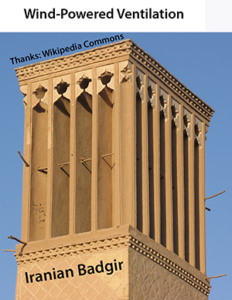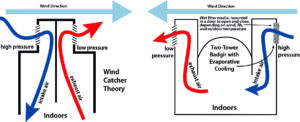 Badgirs — also known as windcatchers or wind towers — are traditional non-electric architectural features used in the Middle East for natural ventilation and cooling. Architects and builders used Babgirs for centuries to create indoor comfort in hot, arid climates. Here’s how they work:
Badgirs — also known as windcatchers or wind towers — are traditional non-electric architectural features used in the Middle East for natural ventilation and cooling. Architects and builders used Babgirs for centuries to create indoor comfort in hot, arid climates. Here’s how they work:
- A badgir uses a vertical shaft that extends above a building’s roof.
- The top of the shaft has openings facing different directions to capture wind from any direction.
- Openings in the shaft catch the wind and channel the air into the building.
- The shaft often contains a separate channel to exhaust hot indoor air to the outdoors
- Cooler entering outdoor air pressurizes the building and pushes hot indoor air out through a exhaust channel in the badgir or through an opening in a high wall or ceiling.
- Some badgirs incorporate a water bowl or wet fabric in the channel to evaporate water, which cools the outdoor air as the water evaporates.
Badgirs work well in dry climates where the relevant design-and-building skills are available. Developing countries possess these skills because they’ve been using non-electric cooling systems for centuries.
For more information on low-cost cooling see Cool Buildings for Hot Weather


